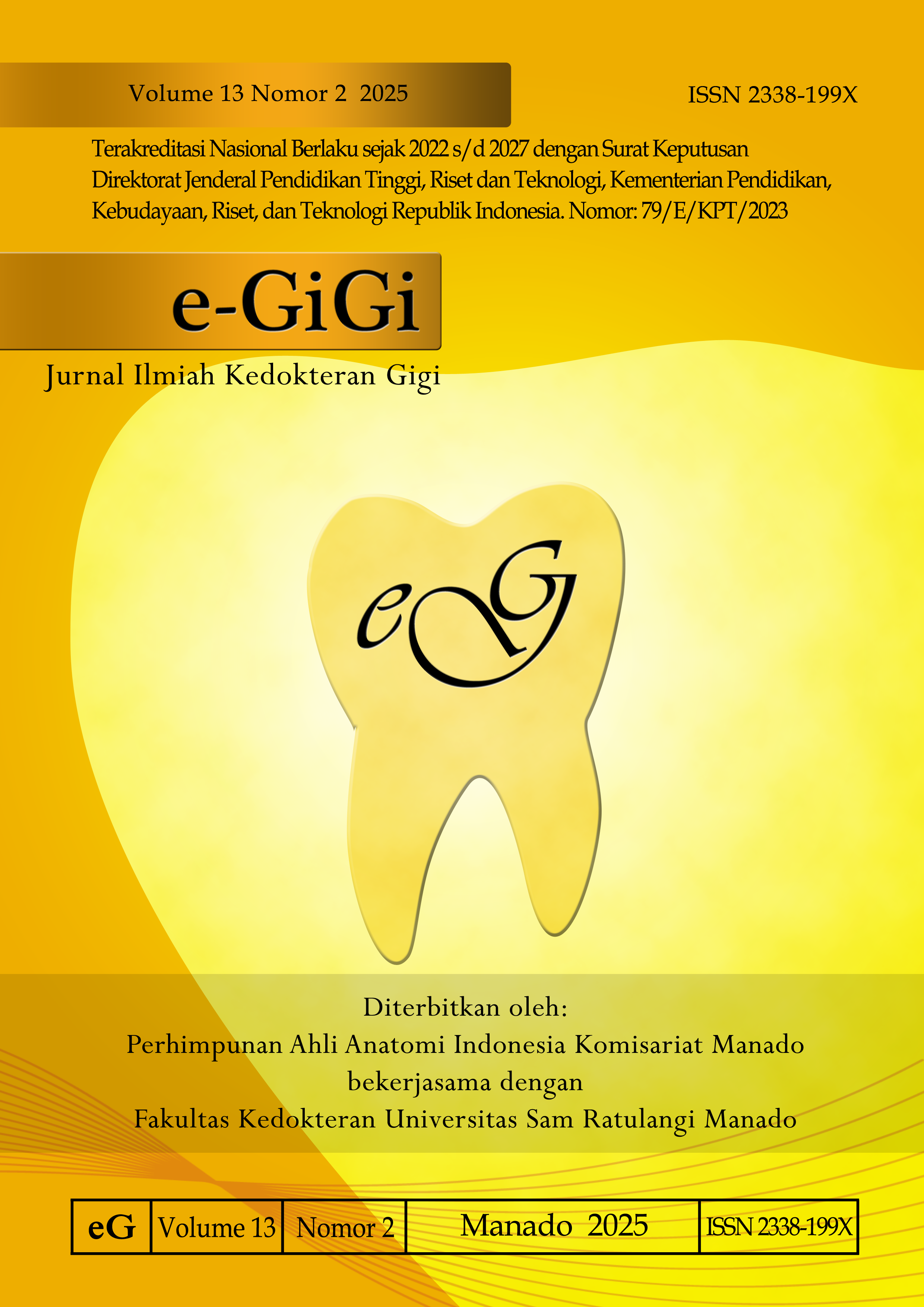Efektivitas Ekstrak Kulit Pisang Sepatu (Musa paradisiaca L.) terhadap Perubahan Warna Gigi yang Terdiskolorasi
DOI:
https://doi.org/10.35790/eg.v13i2.60188Abstract
Abstract: Tooth discoloration is a dental health problem that can affect dental aesthetics. Discoloration can be caused by various factors, one of which is the habit of consuming black tea. Use of chemicals in the process bleaching has a negative effect on teeth. An alternative natural ingredient that has the potential to be utilized is banana peel extract (Musa paradisiaca L.). This study aimed to determine the effectiveness of banana peel extract (Musa paradisiaca L.) in improving the color of discolored teeth. This was a laboratory and experimental study with a pretest-posttest group design. Samples consisted of 30 permanent premolar teeth, divided into three treatment groups, namely the group soaking in banana peel extract for one hour, three hours and five hours. Color measurements were carried out using shade guide (VITAPAN classical). The results of t-paired test showed that were significant changes in tooth color in all groups with p-values ˂0.05 (p=0.002, p=0.000, and p=0.000, consecutively). The largest color change occurred in the group 3 with five hours of soaking. In conclusion, banana peel extract is effective in improving tooth discoloration.
Keywords: banana peel extract (Musa paradisiaca L.); change of tooth color; tooth discoloration
Abstrak: Diskolorasi gigi merupakan masalah kesehatan gigi dan mulut yang dapat memengaruhi estetika gigi. Diskolorasi dapat disebabkan oleh berbagai faktor, salah satunya kebiasaan mengonsumsi teh hitam. Bleaching merupakan cara paling umum yang digunakan untuk menangani masalah diskolorasi gigi. Penggunaan bahan kimia pada proses bleaching memiliki efek negatif terhadap gigi. Alternatif bahan alami yang memiliki potensi untuk dimanfaatkan yaitu ekstrak kulit pisang sepatu (Musa paradisiaca L.). Penelitian ini bertujuan untuk mengetahui efektivitas ekstrak kulit pisang sepatu (Musa paradisiaca L.) terhadap perubahan warna gigi setelah diskolorasi teh hitam. Jenis penelitian ialah eksperimental laboratoris dengan pretest-posttest group design. Sampel berjumlah 30 gigi permanen premolar, yang dibagi ke dalam tiga kelompok perlakuan yaitu kelompok perendaman dalam ekstrak kulit pisang sepatu selama 1 jam, 3 jam, dan 5 jam. Pengukuran warna dilakukan secara visual menggunakan shade guide (VITAPAN classical). Hasil uji t-paired menunjukkan terjadi perubahan warna gigi yang bermakna pada setiap kelompok perendaman dengan nilai p˂0,05, yaitu kelompok 1 dengan nilai p= 0,002; kelompok 2 dengan nilai p=0,000; dan kelompok 3 dengan nilai p=0,000. Perubahan warna terbesar terjadi pada kelompok perendaman selama 5 jam. Simpulan penelitian ini ialah ekstrak kulit pisang sepatu efektif mencerahkan warna gigi yang terdiskolorasi.
Kata kunci: ekstrak kulit pisang sepatu (Musa paradisiaca L); perubahan warna gigi; diskolorasi gigi
References
Badan Penelitian dan Pengembangan Kesehatan. Hasil utama Riset Kesehatan Dasar 2018. Jakarta: Kemenkes RI; 2018. h. 93–6.
Aldaij M, Alshehri T, Alzeer A, Alfayez A, Aldrees F, Almuhaya S, Alkadi N, Alharthi M, Ansari SH. Patient satisfaction with dental appearance and treatment desire to improve esthetics. Oral Health Comm Dent 2018; 12(3): 90 – 5. Doi: 10.5005/jp-journals-10062-0033
Isiekwe GI, Aikins EA.Self-perception of dental appearance and aesthetics in a student population. Int Orthod. 2019;17(3):506-12. Doi: 10.1016/j.ortho.2019.06.010
Hadi L, Muttaqin Z, Adhana A, Halim S, Pasaribu ES, Alfida S, Magfirah Z. Persepsi diri terhadap estetika gigi dan senyum pada mahasiswa kedokteran gigi. Prima Journal of Oral and Dental Sciences. 2021;4(1):1–8. Doi: https://doi.org/10.34012/primajods.v4i1.2395
Noorsaeed AS, Lanqa SAM, Alshehri RA, Linga SAM, Alzahrani RAJ, Ghamdi YKM Al, et al. Causes and management of tooth discoloration: a review. Pharm Res Int. 2021;33:969–76. Doi: 10.9734/jpri/2021/ v33i60B34701.
Wijayadharma K. Perbedaan pengaruh konsumsi teh hijau dan teh hitam kemasan celup terhadap pewarnaan gigi (secara in vitro) [Skripsi]. Jakarta: Universitas Trisakti; 2017.
Istanti SF, Aryati EE, Abrianti K. Pengaruh konsentrasi madu terhadap perubahan warna gigi pada proses pemutihan gigi secara in vitro. Odonto Dent. 2014;1(1):25–8. Doi: http://dx.doi.org/10.30659/odj.1.2.25-28
Bura MAF, Ludong MM, Oessoe YYE. effect of maturity level of kepok banana (Musa paradisiaca formatypica) on chemical and organoleptic properties of frozen fried banana. Agroekoteknologi Terap [Internet]. 2023; 4(1):191–8. Doi: https://doi.org/10.35791/jat.v4i1.44237
Widowati A. Efektivitas ekstrak wortel (Daucus carota L) sebagai bahan alami bleaching pada gigi yang mengalami diskolorasi ektstrinsik [Skripsi]. Malang: Universitas Brawijaya; 2019. Available from: http://repository.ub.ac.id/id/eprint/179172
Nuhu AA. Bioactive micronutrients in coffee: recent analytical approaches for characterization and quantification. ISRN Nutrion. 2014: 2014:384230. Doi: 10.1155%2F2014%2F384230
Sapitri SY, Deynilisa S, Zainur RA. Gambaran pewarnaan gigi (stain) pada masyarakat yang mengonsumsi teh di Desa Gunung Agung Pagar Alam. Jurnal Kesehatan Gigi dan Mulut (JKGM). 2021;3(1):48–51. Doi: https://doi.org/10.36086/jkgm.v3i1.804
Fauziah C, Fitriyani S, Diansari V. Colour of enamel after application of Averrhoa bilimbi. Journal of Dentistry Indonesia. 2012; 19(3):53–6. Doi: http://dx.doi.org/10.14693/jdi.v19i3.134
Irima LA. Pengaruh ekstrak kulit pisang ambon (Musa acuminata) 100% terhadap perubahan warna gigi permanen manusia setelah diskolorasi kopi (in-vitro) [Skripsi]. Medan: Universitas Sumatera Utara; 2018. Available from: http://repositori.usu.ac.id/handle/123456789/8073
Downloads
Published
How to Cite
Issue
Section
License
Copyright (c) 2025 Dinar A. Wicaksono, Ni Wayan Mariati, Regita M. Rawung

This work is licensed under a Creative Commons Attribution-NonCommercial 4.0 International License.
COPYRIGHT
Authors who publish with this journal agree to the following terms:
Authors hold their copyright and grant this journal the privilege of first publication, with the work simultaneously licensed under a Creative Commons Attribution License that permits others to impart the work with an acknowledgment of the work's origin and initial publication by this journal.
Authors can enter into separate or additional contractual arrangements for the non-exclusive distribution of the journal's published version of the work (for example, post it to an institutional repository or publish it in a book), with an acknowledgment of its underlying publication in this journal.
Authors are permitted and encouraged to post their work online (for example, in institutional repositories or on their website) as it can lead to productive exchanges, as well as earlier and greater citation of the published work (See The Effect of Open Access).






